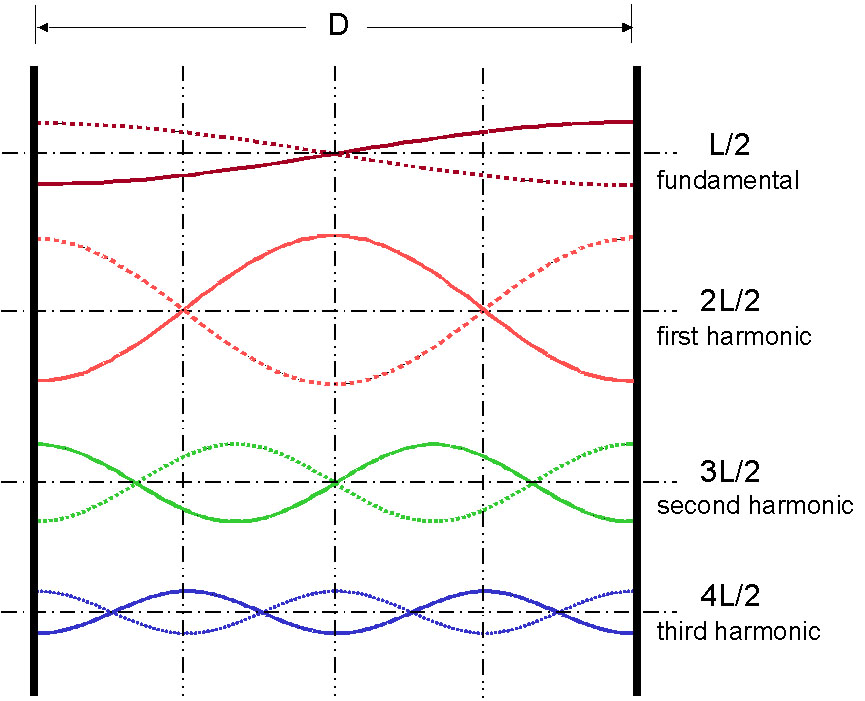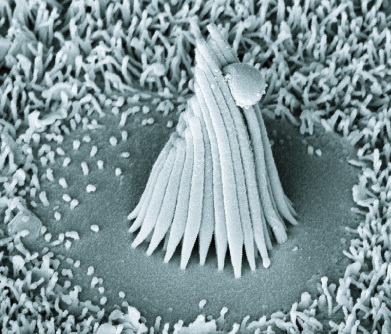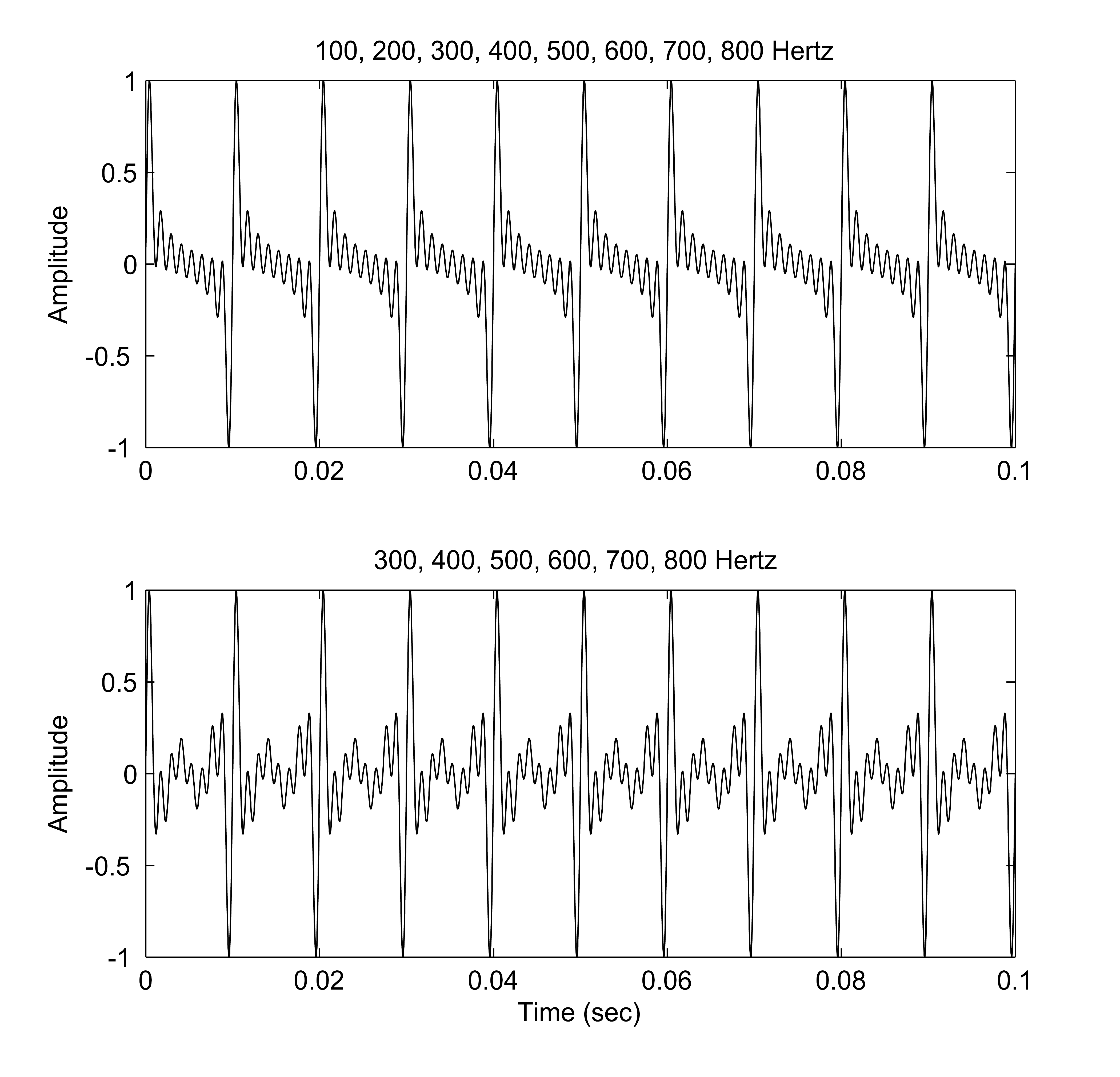Volley Theory on:
[Wikipedia]
[Google]
[Amazon]
 Volley theory states that groups of
Volley theory states that groups of




 Volley theory states that groups of
Volley theory states that groups of neurons
A neuron (American English), neurone (British English), or nerve cell, is an membrane potential#Cell excitability, excitable cell (biology), cell that fires electric signals called action potentials across a neural network (biology), neural net ...
of the auditory system
The auditory system is the sensory system for the sense of hearing. It includes both the ear, sensory organs (the ears) and the auditory parts of the sensory system.
System overview
The outer ear funnels sound vibrations to the eardrum, incre ...
respond to a sound by firing action potentials
An action potential (also known as a nerve impulse or "spike" when in a neuron) is a series of quick changes in voltage across a cell membrane. An action potential occurs when the membrane potential of a specific cell rapidly rises and falls. ...
slightly out of phase with one another so that when combined, a greater frequency of sound can be encoded and sent to the brain to be analyzed. The theory was proposed by Ernest Wever and Charles Bray in 1930 as a supplement to the frequency theory of hearing. It was later discovered that this only occurs in response to sounds ranging from about 500 Hz to 5000 Hz.
Description
The volley theory was explained in depth in Ernest Wever's 1949 book, Theory of Hearing Groups of neurons in thecochlea
The cochlea is the part of the inner ear involved in hearing. It is a spiral-shaped cavity in the bony labyrinth, in humans making 2.75 turns around its axis, the modiolus (cochlea), modiolus. A core component of the cochlea is the organ of Cort ...
individually fire at subharmonic frequencies of a sound being heard and collectively phase-lock to match the total frequencies of the sound. The reason for this is that neurons can only fire at a maximum of about 500 Hz but other theories of hearing did not explain for hearing sounds below about 5000 Hz.

Harmonic spectrums
Sounds are often sums of multiple frequency tones. When these frequencies are whole number multiples of afundamental frequency
The fundamental frequency, often referred to simply as the ''fundamental'' (abbreviated as 0 or 1 ), is defined as the lowest frequency of a Periodic signal, periodic waveform. In music, the fundamental is the musical pitch (music), pitch of a n ...
they create a harmonic
In physics, acoustics, and telecommunications, a harmonic is a sinusoidal wave with a frequency that is a positive integer multiple of the ''fundamental frequency'' of a periodic signal. The fundamental frequency is also called the ''1st har ...
. When groups of auditory neurons are presented with harmonics, each neuron fires at one frequency and when combined, the entire harmonic is encoded into the primary auditory cortex
The auditory cortex is the part of the temporal lobe that processes auditory information in humans and many other vertebrates. It is a part of the auditory system, performing basic and higher functions in hearing, such as possible relations to ...
of the brain. This is the basis of volley theory.
Phase-locking
Phase-locking is known as matching amplitude times to a certain phase of another waveform. In the case of auditory neurons, this means firing an action potential at a certain phase of a stimulus sound being delivered. It has been seen that when being played apure tone
In psychoacoustics, a pure tone is a sound with a sinusoidal waveform; that is, a sine wave of constant frequency, phase-shift, and amplitude.
By extension, in signal processing a single-frequency tone or pure tone is a purely sinusoidal signal ...
, auditory nerve fibers will fire at the same frequency as the tone. Volley theory suggests that groups of auditory neurons use phase-locking to represent subharmonic frequencies of one harmonic sound. This has been shown in guinea pig and cat models.
In 1980, Don Johnson experimentally revealed phase-locking in the auditory nerve fibers of the adult cat. In the presence of -40 to -100 decibel single tones lasting 15 or 30 seconds, recordings from the auditory nerve fibers showed firing fluctuations in synchrony with the stimulus. Johnson observed that during frequencies below 1000 Hz, two peaks are recorded for every cycle of the stimulus, which had varying phases according to stimulation frequency. This phenomenon was interpreted as the result of a second harmonic, phase-locking to the stimulus waveform. However, at frequencies between about 1000 Hz and 5000 Hz, phase-locking becomes progressively inaccurate and intervals tend to become more random.
Pitch perception
Pitch is an assigned, perceptual property where a listener orders sound frequencies from low to high. Pitch is hypothesized to be determined by receiving phase-locked input from neuronal axons and combining that information into harmonics. In simple sounds consisting of one frequency, the pitch is equivalent to the frequency. There are two models of pitch perception; a spectral and a temporal. Low frequency sounds evoke the strongest pitches, suggesting that pitch is based on the temporal components of the sound. Historically, there have been many models of pitch perception. (Terhardt, 1974; Goldstein, 1973; Wightman, 1973). Many consisted of a peripheral spectral-analysis stage and a central periodicity-analysis stage. In his model, Terhardt claims that the spectral-analysis output of complex sounds, specifically low frequency ones, is a learned entity which eventually allows easy identification of the virtual pitch. The volley principle is predominantly seen during the pitch perception of lower frequencies where sounds are often resolved. Goldstein proposed that through phase-locking and temporal frequencies encoded in neuron firing rates, the brain has the itemization of frequencies that can then be used to estimate pitch.Discovery and history
Throughout the nineteenth century, many theories and concepts of hearing were created. Ernest Wever proposed the volley theory in 1937 with his paper "The Perception of Low Tones and the Resonance-Volley Theory". In this paper, Wever discusses previous theories of hearing and introduces volley theory using support from his own experiments and research. The theory was introduced as a supplement to the frequency theory or temporal theory of hearing, which was in contrast to the place theory of hearing.Place theory
The most prominent figure in the creation of the place theory of hearing isHermann von Helmholtz
Hermann Ludwig Ferdinand von Helmholtz (; ; 31 August 1821 – 8 September 1894; "von" since 1883) was a German physicist and physician who made significant contributions in several scientific fields, particularly hydrodynamic stability. The ...
, who published his finished theory in 1885. Helmholtz claimed that the cochlea contained individual fibers for analyzing each pitch and delivering that information to the brain. Many followers revised and added to Helmholtz's theory and the consensus soon became that high frequency sounds were encoded near the base of the cochlea and that middle frequency sounds were encoded near the apex. Georg von Békésy
Georg von Békésy (, ; 3 June 1899 – 13 June 1972) was a Hungarian-American biophysicist.
By using strobe photography and silver flakes as a marker, he was able to observe that the basilar membrane moves like a surface wave when stimulated b ...
developed a novel method of dissecting the inner ear
The inner ear (internal ear, auris interna) is the innermost part of the vertebrate ear. In vertebrates, the inner ear is mainly responsible for sound detection and balance. In mammals, it consists of the bony labyrinth, a hollow cavity in the ...
and using stroboscopic illumination to observe the basilar membrane
The basilar membrane is a stiff structural element within the cochlea of the inner ear which separates two liquid-filled tubes that run along the coil of the cochlea, the scala media and the scala tympani. The basilar membrane moves up and down ...
move, adding evidence to support the theory.
Frequency theory
Ideas related to the frequency theory of hearing came about in the late 1800s as a result of the research of many individuals. In 1865,Heinrich Adolf Rinne
Heinrich Adolf Rinne (January 24, 1819 – July 26, 1868) was a German otologist born in Vlotho an der Weser.
He received his doctorate from the University of Göttingen and practiced medicine in the city of Göttingen. Later he was a physician ...
challenged the place theory; he claimed that it’s not very efficient for complex sounds to be broken into simple sounds then be reconstructed in the brain. Later, Friedrich Voltolini added on by proposing that every auditory hair cell
Hair cells are the sensory receptors of both the auditory system and the vestibular system in the ears of all vertebrates, and in the lateral line organ of fishes. Through mechanotransduction, hair cells detect movement in their environment. ...
is stimulated by any sound. Correspondingly, William Rutherford provided evidence that this hypothesis was true, allowing greater accuracy of the cochlea. In 1886, Rutherford also proposed that the brain interpreted the vibrations of the hair cells and that the cochlea did no frequency or pitch analysis of the sound. Soon after, Max Friedrich Meyer
Max Friedrich Meyer (June 14, 1873 – March 14, 1967) was the first psychology professor who worked on psychoacoustics and taught at the University of Missouri. He was the founder of the theory of cochlear function, and was also an advocate ...
, among other ideas, theorized that nerves would be excited at the same frequency of the stimulus.
Volley theory
Of the various theories and notions created by Rinne, Rutherford, and their followers, the frequency theory was born. In general, it claimed that all sounds were encoded to the brain by neurons firing at a rate that mimics the frequency of the sound. However, because humans can hear frequencies up to 20,000 Hz but neurons cannot fire at these rates, the frequency theory had a major flaw. In an effort to combat this fault, Ernest Wever and Charles Bray, in 1930, proposed the volley theory, claiming that multipleneurons
A neuron (American English), neurone (British English), or nerve cell, is an membrane potential#Cell excitability, excitable cell (biology), cell that fires electric signals called action potentials across a neural network (biology), neural net ...
could fire in a volley to later combine and equal the frequency of the original sound stimulus. Through more research, it was determined that because phase synchrony is only accurate up to about 1000 Hz, volley theory cannot account for all frequencies at which we hear.
Present thoughts
Ultimately, as new methods of studying the inner ear came about, a combination of place theory and frequency theory was adopted. Today, it is widely believed that hearing follows the rules of the frequency theory, including volley theory, at frequencies below 1000 Hz and place theory at frequencies above 5000 Hz. For sounds with frequencies between 1000 and 5000 Hz, both theories come into play so the brain can utilize the basilar membrane location and the rate of the impulse.Experimental evidence
Due to the invasiveness of most hearing related experiments, it is difficult to use human models in the study of the auditory system. However, many findings have been revealed in cats and guinea pigs. Additionally, there are few ways to study the basilar membrane ''in vivo''.Sound Stimuli
Many revolutionary concepts regarding hearing and encoding sound in the brain were founded in the late nineteenth and early twentieth centuries. Various tools were used to induce a response in auditory nerves, and that were to be recorded. Experiments by Helmholtz, Wever, and Bray often involved the use of organ pipes, stretched springs, loaded reeds, lamellas, vibrating forks, beats, and interruption tones to create “clicks”, harmonics, or pure tones. Today,electronic oscillators
An electronic oscillator is an electronic circuit that produces a periodic, oscillating or alternating current (AC) signal, usually a sine wave, square wave or a triangle wave, powered by a direct current (DC) source. Oscillators are found in ...
are often used to create sinusoidal or square waves of precise frequencies.
Electrophysiology
Attempts to electrically record from the auditory nerve began as early as 1896. Electrodes were placed into the auditory nerve of various animal models to give insight on the rate at which the neurons are firing. In a 1930 experiment involving the auditory nerve of a cat, Wever and Bray found that 100–5000 Hz sounds played to the cat produced similar frequency firing in the nerve. This supported the frequency theory and the volley theory.
Stroboscopic illumination
Pioneered byGeorg von Békésy
Georg von Békésy (, ; 3 June 1899 – 13 June 1972) was a Hungarian-American biophysicist.
By using strobe photography and silver flakes as a marker, he was able to observe that the basilar membrane moves like a surface wave when stimulated b ...
, a method to observe the basilar membrane in action came about in the mid 1900s. Békésy isolated the cochlea from human and animal cadavers and labeled the basilar membrane with silver flakes. This allowed strobe imaging to capture the movement of the membrane as sounds stimulated the hair cells. This led to the solidification of the idea that high frequencies excite the basal end of the cochlea and provided new information that low frequencies excite a large area of the cochlea. This new finding suggested that specialized properties are occurring for high frequency hearing and that low frequencies involve mechanisms explained in the frequency theory.

Missing fundamental
A fundamental frequency is the lowest frequency of a harmonic. In some cases, sound can have all the frequencies of a harmonic but be missing the fundamental frequency, this is known asmissing fundamental
The pitch being perceived with the first harmonic being absent in the waveform is called the missing fundamental phenomenon.
It is established in psychoacoustics that the auditory system, with its natural tendency to distinguish a tone from anoth ...
. When listening to a sound with a missing fundamental, the human brain
The human brain is the central organ (anatomy), organ of the nervous system, and with the spinal cord, comprises the central nervous system. It consists of the cerebrum, the brainstem and the cerebellum. The brain controls most of the activi ...
still receives information for all frequencies, including the fundamental frequency which does not exist in the sound. This implies that sound is encoded by neurons firing at all frequencies of a harmonic, therefore, the neurons must be locked in some way to result in the hearing of one sound.
Hearing loss and deafness
Congenital deafness orsensorineural hearing loss
Sensorineural hearing loss (SNHL) is a type of hearing loss in which the root cause lies in the inner ear, sensory organ (cochlea and associated structures), or the vestibulocochlear nerve (Cranial nerves, cranial nerve VIII). SNHL accounts for a ...
is an often used model for the study of the inner ear regarding pitch perception and theories of hearing in general. Frequency analysis
In cryptanalysis, frequency analysis (also known as counting letters) is the study of the frequency of letters or groups of letters in a ciphertext. The method is used as an aid to breaking classical ciphers.
Frequency analysis is based on th ...
of these individuals’ hearing has given insight on common deviations from normal tuning curves, excitation patterns, and frequency discrimination ranges. By applying pure or complex tones, information on pitch perception can be obtained. In 1983, it was shown that subjects with low frequency sensorineural hearing loss demonstrated abnormal psychophysical tuning curves. Changes in the spatial responses in these subjects showed similar pitch judgment abilities when compared to subjects with normal spatial responses. This was especially true regarding low frequency stimuli. These results suggest that the place theory of hearing does not explain pitch perception at low frequencies, but that the temporal (frequency) theory is more likely. This conclusion is due to the finding that when deprived of basilar membrane place information, these patients still demonstrated normal pitch perception. Computer models for pitch perception and loudness perception are often used during hearing studies on acoustically impaired subjects. The combination of this modeling and knowledge of natural hearing allows for better development of hearing aids.
References
{{DEFAULTSORT:Volley Theory Auditory system Neural coding